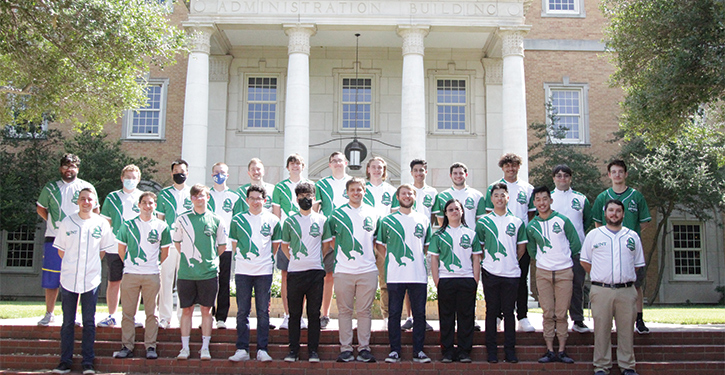When esports at the University of North Texas (UNT) was first offered, gamers only had one space to use, and it was shared with the media library. But due to unprecedented growth in interest, UNT has expanded its efforts.
“Since then, we realized we needed more facility time for students wanting to use the space,” said Dylan Wray, the assistant director of UNT Esports. “The end result is the varsity team has their own space, and open recreation now has their own lab. The open lab is the most important component to any program right now. It’s a meeting ground of people who love to game and something we should always keep doing. It’s how to ingrain esports into the college experience. That’s been a big change for us.”
Similar changes can also be found at Franklin College where Todd Burris, the director of Esports and head coach, said they recently took an unused racquetball court and turned it into an esports gaming arena.
EXTRA CREDIT: Learn more about the esports program at Franklin College here.
“I built this program from the ground up a few years ago,” said Burris. “When they hired me, I inherited maybe five kids. I started recruiting on campus to grow the program, and we now have over 40 students. It’s turned into something that’s very popular. We use esports at Franklin College to leverage our mission and retain students.”
Burris said once you combine views across all platforms, esports is now the second most-watched sport in the U.S. behind the NFL. The surge in popularity has led to a spike in the number of programs at colleges offering gaming opportunities for students.

But with fast progress comes a few growing pains. Specifically, Burris said while esports offers exciting competitive opportunities for traditional and non-traditional students, the lack of structure or governing body causes difficulties to emerge.
“I think some of the biggest changes have been the number of conferences popping up,” said Burris. “My gut tells me esports is still the wild, wild west. The NCAA needs to take it over. I think that’s what needs to happen. We’re competing against some incredibly talented schools. We’ve been very successful but, for example, no one expects our football team to compete against the University of Alabama’s. If esports is going to have a future, it needs to be governed by the NCAA.”
The University of Tennessee at Chattanooga (UTC) is also seeing struggles from the lack of structure in the sport. Cindy Strine, the director of Campus Recreation at UTC, said since there is no governing body or regulations, schools regularly solicit players from other schools to transfer by offering scholarships and incentives.
EXTRA CREDIT: Here are eight considerations when building out an esports lounge.
“Major changes happen year-to-year to address issues from the previous year or to improve the player experience,” said Strine. “Esports is growing simultaneously at the collegiate and high school levels. Esports at the collegiate level is now housed in a variety of departments like athletics, recreation, student unions, academics and student organizations depending upon the institution.”
Recently, UTC has created an esports arena, added scholarships, revamped its esports website and expanded their competitive team offerings. Strine said they’re also improving their Twitch channel and finding additional spaces on campus. UTC currently uses Alienware gaming PCs for hardware. Management solutions GGLeagues and ggCircuit are their software vendors.

“We’ll be focusing on more content creation including YouTube videos, Instagram and TikTok,” said Strine. “UTC continues broader discussions across campus on the future of gaming and esports within the curriculum and in co-curricular activities. An upcoming renovation to the University Center includes an esports space that better meets the needs of our teams.”
EXTRA CREDIT: Did you know only 8.2% of collegiate esports players are women? Here’s are to get more women involved.
For UNT, the future of the Esports program looks to be increasing its inclusiveness. Wray said while he still sees programs that only do athletic-style competitions, they will be offering more informal opportunities.
“As our programs get more resources to facilitate varsity competition, I know for a fact we’re shifting gears to dedicate more time and resources to keep casual gaming growing and more engaged,” said Wray. “There’s so much more to gaming besides varsity-level competition. We should err on the side of fun. A program doesn’t have to be something super fancy. It can sometimes just be a simple get-together. The intramural option is also an excellent way to easily engage students.”
To offer such services, Wray said they have a supportive sponsor in RGB CustomPC that supplies customized gaming PCs. They also use a company called CORSAIR for keyboards and mice, and another vendor named HyperX for gaming headsets.
But no matter what equipment is used to help run esports, the key to finding success is to determine the overall purpose of the program. Being direct about this focus is a key strategy for Strine at UTC.
“Each college or university must define its level of engagement, direction, philosophy and commitment to esports and gaming,” said Strine. “Campus, departmental and student priorities will help determine the growth and development of esports at a particular school. Esports will continue to be very unpredictable with frequent shifts and changes for years to come.”











